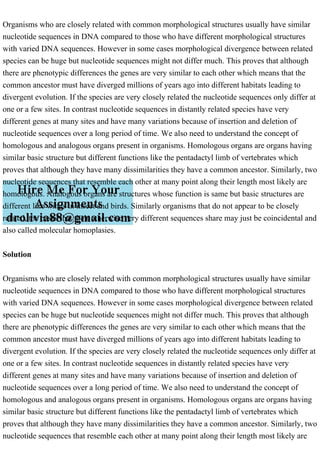Organisms who are closely related with common morphological structur.pdf
Organisms who are closely related with common morphological structures usually have similar nucleotide sequences in DNA compared to those who have different morphological structures with varied DNA sequences. However in some cases morphological divergence between related species can be huge but nucleotide sequences might not differ much. This proves that although there are phenotypic differences the genes are very similar to each other which means that the common ancestor must have diverged millions of years ago into different habitats leading to divergent evolution. If the species are very closely related the nucleotide sequences only differ at one or a few sites. In contrast nucleotide sequences in distantly related species have very different genes at many sites and have many variations because of insertion and deletion of nucleotide sequences over a long period of time. We also need to understand the concept of homologous and analogous organs present in organisms. Homologous organs are organs having similar basic structure but different functions like the pentadactyl limb of vertebrates which proves that although they have many dissimilarities they have a common ancestor. Similarly, two nucleotide sequences that resemble each other at many point along their length most likely are homologous. Analogous organs are structures whose function is same but basic structures are different like wings in insect and birds. Similarly organisms that do not appear to be closely related, the bases that their otherwise very different sequences share may just be coincidental and also called molecular homoplasies. Solution Organisms who are closely related with common morphological structures usually have similar nucleotide sequences in DNA compared to those who have different morphological structures with varied DNA sequences. However in some cases morphological divergence between related species can be huge but nucleotide sequences might not differ much. This proves that although there are phenotypic differences the genes are very similar to each other which means that the common ancestor must have diverged millions of years ago into different habitats leading to divergent evolution. If the species are very closely related the nucleotide sequences only differ at one or a few sites. In contrast nucleotide sequences in distantly related species have very different genes at many sites and have many variations because of insertion and deletion of nucleotide sequences over a long period of time. We also need to understand the concept of homologous and analogous organs present in organisms. Homologous organs are organs having similar basic structure but different functions like the pentadactyl limb of vertebrates which proves that although they have many dissimilarities they have a common ancestor. Similarly, two nucleotide sequences that resemble each other at many point along their length most likely are homologous. Analogous organs are structures whose funct.

Recommended
Recommended
More Related Content
Similar to Organisms who are closely related with common morphological structur.pdf
Similar to Organisms who are closely related with common morphological structur.pdf (20)
More from LAMJM
More from LAMJM (20)
Recently uploaded
Recently uploaded (20)
Organisms who are closely related with common morphological structur.pdf
- 1. Organisms who are closely related with common morphological structures usually have similar nucleotide sequences in DNA compared to those who have different morphological structures with varied DNA sequences. However in some cases morphological divergence between related species can be huge but nucleotide sequences might not differ much. This proves that although there are phenotypic differences the genes are very similar to each other which means that the common ancestor must have diverged millions of years ago into different habitats leading to divergent evolution. If the species are very closely related the nucleotide sequences only differ at one or a few sites. In contrast nucleotide sequences in distantly related species have very different genes at many sites and have many variations because of insertion and deletion of nucleotide sequences over a long period of time. We also need to understand the concept of homologous and analogous organs present in organisms. Homologous organs are organs having similar basic structure but different functions like the pentadactyl limb of vertebrates which proves that although they have many dissimilarities they have a common ancestor. Similarly, two nucleotide sequences that resemble each other at many point along their length most likely are homologous. Analogous organs are structures whose function is same but basic structures are different like wings in insect and birds. Similarly organisms that do not appear to be closely related, the bases that their otherwise very different sequences share may just be coincidental and also called molecular homoplasies. Solution Organisms who are closely related with common morphological structures usually have similar nucleotide sequences in DNA compared to those who have different morphological structures with varied DNA sequences. However in some cases morphological divergence between related species can be huge but nucleotide sequences might not differ much. This proves that although there are phenotypic differences the genes are very similar to each other which means that the common ancestor must have diverged millions of years ago into different habitats leading to divergent evolution. If the species are very closely related the nucleotide sequences only differ at one or a few sites. In contrast nucleotide sequences in distantly related species have very different genes at many sites and have many variations because of insertion and deletion of nucleotide sequences over a long period of time. We also need to understand the concept of homologous and analogous organs present in organisms. Homologous organs are organs having similar basic structure but different functions like the pentadactyl limb of vertebrates which proves that although they have many dissimilarities they have a common ancestor. Similarly, two nucleotide sequences that resemble each other at many point along their length most likely are
- 2. homologous. Analogous organs are structures whose function is same but basic structures are different like wings in insect and birds. Similarly organisms that do not appear to be closely related, the bases that their otherwise very different sequences share may just be coincidental and also called molecular homoplasies.